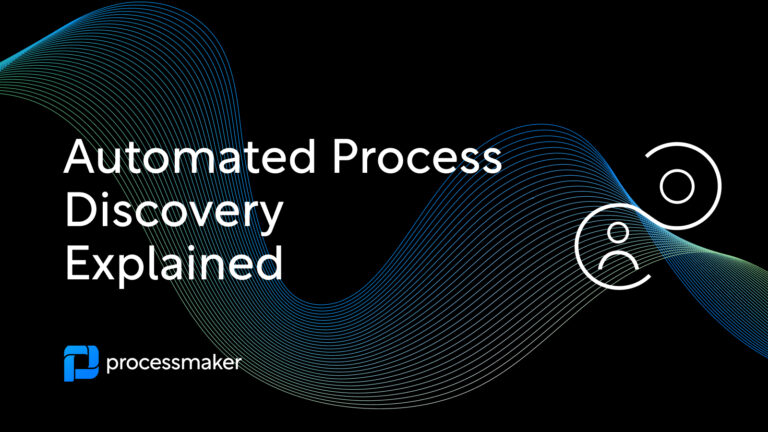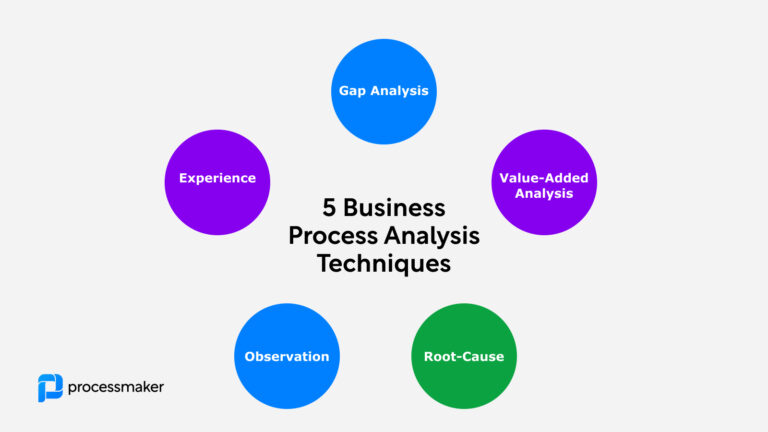As we develop the increasingly digital workplace, it’s critical to understand and utilize the tools at our disposal to maximize efficiency and productivity.
One such technology is Automated Process Discovery (APD), a broad set of tools and methods that can revolutionize the way businesses operate. These tools systematically identify, map, and analyze business processes to provide crucial insights for process improvement and automation efforts. Let’s look at what they are, how they work and top tips on getting started.
What is automated process discovery?
Automated process discovery (APD) is a broad field within business process management that covers any tools or automation methods that help you discover the “as-is” state of business processes in order to improve them.
Automated process discovery improves on many of the limitations of manual process discovery. In the past, business process discovery was conducted either through direct observation of work or through process discovery workshops or interviews of key stakeholders. In all these cases, it was a time-consuming exercise requiring significant effort and frequently leading to subjective or erroneous findings.
Today, there are over 20 different automated process discovery tools available in the market. Some common APD tools include process mining software, task mining tools, and self-built process analytics leveraging business intelligence platforms.
APD tools often use machine learning (ML) and process mining algorithms to identify, analyze, and visualize business processes. This technology automatically traces and maps the digital footprints left by various activities within a system, creating an accurate, real-time picture of business operations. These tools not only identify but also continuously optimize processes by analyzing processes for improvements.
Key process discovery steps that can be automated
Business process discovery can either be fully automated, or you can use automation in key steps of the process discovery process. Let’s outline how automation impacts each step of process discovery.
Data collection
Process discovery tools such as process mining or task mining solutions can automate data collection. This data can come from a variety of sources, including system logs, employee interviews, and direct observation. The goal is to collect as much data as possible about the steps involved in each process, who performs them, and in what order.
The collected data can be documented in detail and exported as process definition documents for further analysis and automation.
Discovery of “as-is processes”
APD tools can excel in identifying the true state of processes in a data-driven way. This could be any process that is critical to your business operations, such as order fulfillment, customer service interactions, or product development processes – or this could be shadow processes or workflows that are not mapped or documented. Understanding process execution can lead to improved risk management by identifying vulnerabilities and enabling data-driven decision-making.
Process mapping
Once you’ve automatically extracted and collected process data, the next step is to create a visual representation of the process. While you can create process maps and directly follow visualizations manually, there are many software solutions to automatically map both as-is and should-be processes and process models. These visualizations can help stakeholders understand the process and identify areas for improvement. Process transparency is crucial for optimizing business processes by providing a clear and secure view of automation efforts.
Conformance checking
After mapping the process, it’s important to validate it regularly to maintain conformance to the plan. This involves sharing the process map with stakeholders and those who perform the process to ensure it accurately represents reality. Automated conformance checking is a regular feature within many task mining and process mining solutions.
Automated Insights
The final step in process discovery is to use the insights gained to improve the process. This could involve removing unnecessary steps, automating manual tasks, or redesigning the process entirely. Some process intelligence solutions, such as Workfellow, offer prescriptive analytics and automated insights as part of process discovery.
Benefits of automated process discovery
Automated Process Discovery highlights the benefits of process discovery, including eliminating the need for manual process mapping, which is time-consuming and prone to human error. By automating this, businesses can focus on improving processes rather than identifying them.
As with any manual task, process mapping is susceptible to human error. APD reduces this risk by accurately capturing processes as they occur, leading to more accurate data and insights.
APD allows businesses to scale their process discovery efforts with ease. As a company grows, so too do its processes. APD can keep up with this growth, providing constant and accurate process maps and timely process analytics.
Process Discovery Use Cases by Industry
Automated process discovery is a versatile tool that can be applied across various industries to optimize business processes, enhance efficiency, and reduce operational costs. Here are some compelling examples of how different sectors leverage process discovery:
Examples and Applications
The Evolution of Process Discovery
The journey of process discovery has evolved significantly, transitioning from manual efforts to sophisticated automated solutions. Here’s a brief overview of this evolution:
From Manual to Automated
Understanding the Stakeholders in Process Discovery
Successful process discovery initiatives involve a diverse range of stakeholders, each playing a critical role in ensuring alignment with business goals. Here are some of the key stakeholders and their responsibilities:
Roles and Responsibilities
Examples of process discovery tools
The field of automated process discovery is broad, and you may find many solutions for different types of organization types, business processes, and key use cases.
Process Mining
Process mining tools use event logs from information systems to discover processes. They provide an accurate and objective view of processes but require clean and comprehensive data to be effective. Process mining tools provide business users with a deep level of analysis for process improvement, often covering thousands or even millions of process variations. Process mining tools can be used for both process discovery and continuous business process improvement.
Task Mining
Task mining is another form of APD that involves using task capture and AI to analyze user interactions and discover processes. It’s beneficial for processes that involve a lot of human interaction and can provide insights into how tasks are performed. Task mining tools are especially valuable in finding automatable processes, as they identify in detail the manual tasks done across workflows, and can identify inefficiencies that don’t get filed in IT system event logs.
Self-built process analytics
The third option for automating process discovery is using process mining algorithms and data science to create your own process discovery dashboards and models within business intelligence platforms. Today, there are many open source libraries, eg. process mining algorithms that allow you to do your own process discovery using programming languages such as Python and standard BI visualization tools, such as Tableau or Power BI.
The need for a process discovery framework
Today there are many ways for automating business process discovery. It’s important to remember, that discovery is only the start of business process analysis. For long-lasting results, process optimization requires continuous data analysis and iteration to turn existing processes into more effective process models, or automated workflows.
It helps to leverage a process discovery framework to clarify and communicate how process discovery serves as a launchpad for process optimization and digital transformation. With a clear framework and operating model, process discovery can be a source of competitive advantage to deliver cost savings, identify automation opportunities, implement strategic automation initiatives to enhance efficiency, and standardize key process steps and workflows. Building a case for process discovery?
Automated Process Discovery Q&A
1. What is business process discovery?
Process discovery is the act of defining, mapping, and understanding a business process. It’s a critical first step in any process improvement initiative. The best process discovery method depends on the specific needs and resources of an organization. Manual process discovery can be effective for small or simple processes, while automated process discovery is more suited to large or complex processes.
2. Why is process discovery important?
Process discovery is vital for organizations as it provides a clear understanding of their business processes, which is the first step towards process improvement. It reveals the actual sequence of tasks performed, identifies who performs them, and uncovers inefficiencies, bottlenecks, and areas of waste or risk within a process. This detailed understanding helps organizations streamline their operations, enhance productivity, and reduce errors, leading to improved performance and competitiveness. Additionally, process discovery forms the basis for other strategic initiatives like Robotic Process Automation (RPA) and Business Process Management (BPM), making it a critical component in an organization’s digital transformation journey. By continuously monitoring and updating their process maps, organizations can also ensure they adapt to changing business environments and maintain operational efficiency.
3. How does process discovery help RPA?
Process discovery plays a critical role in Robotic Process Automation (RPA) by providing a clear understanding of the tasks and processes that could potentially be automated. It enables organizations to accurately map out their business processes, identify redundancies, pinpoint bottlenecks, and observe variations. By doing so, process discovery helps in identifying suitable candidates for automation, laying a solid foundation for RPA initiatives. Furthermore, the detailed insights gained from process discovery guide the design, implementation, and maintenance of bots, ensuring that they can accurately replicate the desired tasks. Consequently, this leads to more effective automation, improved efficiency, reduced errors, and increased return on investment in RPA technology.
4. What are examples of automated process analysis?
Automated process discovery methods leverage technology to automatically trace and map out business processes, reducing the time and effort involved in manual process mapping. One example is Process Mining, which utilizes event logs generated by enterprise systems to create a detailed visual map of a process. It identifies the sequence of tasks, their dependencies, and variations, providing an objective view of the process based on factual data. Another example is Task Mining, which applies AI and machine learning to user interaction data, such as screen recordings or keystrokes, to map out processes. It’s particularly useful for processes involving a lot of human interaction. Automated process discovery methods provide a more accurate, efficient, and objective approach to process discovery compared to traditional manual methods.





